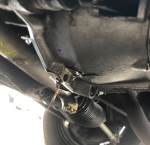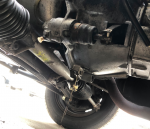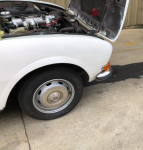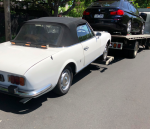Hi Everyone, I have the start of a conundrum which I'd love any thoughts and insight into please. Car: 1972 504 Cabriolet, Manual 4 speed, with the 2.0L Kugelfischer fuel injection (so anyone familiar with Ti will know the configuration..
- Situation: Car running perfectly, I have just had it shipped Mel to Syd, and upon arrival in Sydney, there was a huge pool of oil under the car, and no oil registering on the dip stick (see the pictures) While in the car yard, I put about 1.5 litres of oil into the engine (just to test really) and immediately a flow of liquid came from the inspection hole in the bottom of the clutch bell housing area. That liquid was mostly petrol
?!! Having seen the mess, the car is now on its final journey to my garage.
- Questions: it is not the oil sump plug If the car has been man handled by a fork lift truck (quite likely imo as that was how all the cars being handled appeared to be moved about) has that 'bent, cracked, something?
- Another thought? The key was left in the ignition, and battery flat, is it possible that someone left the ignition 'on' and the lift pump near the fuel tank have stayed running... could that have pushed fuel into the engine area... maybe putting petrol via the inlet manifold, into the engine via an open valve? such that petrol has filled the whole sump and overflowed ... somehow, into the clutch area??
- Any thoughts are appreciated as I am in investigation mode... clearly
r's mike
- (sorry about the formatting)
Attachments
Last edited:




